Sony RX100 III vs Panasonic LX100 vs Canon G7 X
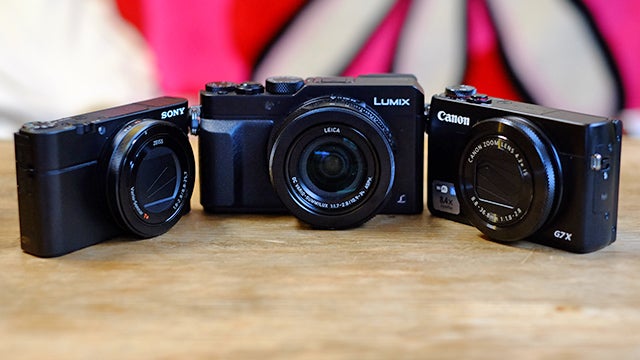
Battle of the big-sensor compacts
The
era of the big-sensor compact is here. If you thought your phone was as
good as a compact camera, you need to see what these are capable of.
Where once the Sony RX100 series was just about the only good option in this field, we now have the Panasonic Lumix LX100 and Canon G7 X to consider. But which one is the best?
We’ve been spending some time with these cameras to find out.
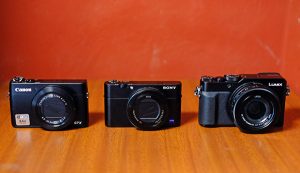
Design and Basic Handling
These
are all compact cameras. They don’t have removable lenses or giant
sensors, and it helps keep the lot of them a good deal more portable
than compact system cameras. That’s the whole point of this relatively
new ‘large sensor, small body’ class.
However, among these three, there’s a clear distinction between the Sony RX100 III and Canon G7 X in one group, and the Panasonic Lumix LX100 in another.
Canon
has designed the G7 X to mimic the dimensions and shape of the Sony
RX100 range, which has maintained similar dimensions since the series
began in 2012. The Panasonic Lumix LX100 takes a different approach.
It’s significantly larger, both in terms of its body footprint and how
far the lens sticks out from the body. Here are the dimensions for a
direct comparison…
Sony RX100 III: 101.6 x 58.1 x 41.0mm
Canon G7 X: 103 x 60 x 40 mm
Panasonic Lumix LX100: 114.8 x 66.2 x 61.1 mm
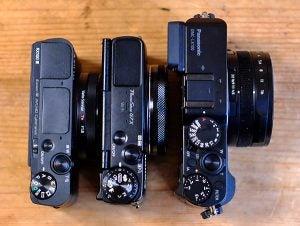
The
LX100 feels much less like an ordinary compact that the others, but
this is something Panasonic has embraced. For example, it’s the only one
of the three not to offer a motorised lens cover, meaning you need to
keep an eye on where you put the lens cap, just like you do with an
interchangeable-lens camera.
Those after a tiny partner to a
DSLR or high-end CSC may appreciate that the Canon G7 X and Sony RX100
III will slip into a pocket, where doing so with an LX100 feels like
trying to fit a rubber glove over your head — you can do it with some
effort, but it’s just not right.
However, this is far from an
all-out fail for the Panasonic. It’s merely a case of these cameras
having different priorities, with the LX100 sensibly separating itself
from the incredibly popular RX100 line. It offers something altogether
different.
For example, it’s the only one of the three to offer a
proper handgrip. It’s small, but rubberised and well designed. It gives
the Panasonic LX100 a surer grip and a sense of being a more
substantial camera than the other two. It feels similar to Fujifilm
X-series cameras such as the X100T and X30: compact, but with a
reassuring side of old-school flavour.
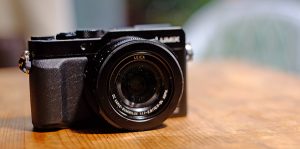
The
most slippery of the lot is the Sony RX100 III, which has a very
smart-looking lightly textured metal finish. The Canon G7 X inhabits a
middle ground. It has no hand grip, but offers a more pronounced ‘paint
fleck’ texture that offers more resistance.
However,
the Canon G7 X is probably the least ergonomically pleasing of the lot.
Its two-tiered mode dial is an attraction, but detracts from comfort
when you have a finger perched over the shutter button.
The Sony and Panasonic are the handling winners, depending on whether portability or a rugged feel is more important to you.
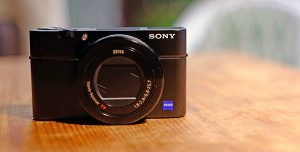
Construction and Build Quality
Surprisingly
enough, given that it’s the cheapest of the three, it’s the Canon G7 X that
actually has the most metal on show. Aside from the flaps that cover the
ports on its sides and bottom, all of its main panels are metal. The
underside of the display is the only large part that’s plastic.
The Panasonic LX100 and Sony RX100 III are mostly metal, but both make greater use of plastic.
If
we’re to dub the use of plastic a crime, the Sony RX100 III is the
worst offender. Its front panel, which curves around to form the top
plate, is metal, but the whole back is plastic. Of course, the effects in use are very, very minor.
Most of the RX100 III’s
back is taken up by the glass-covered display, and where you rest your
thumb on the back is covered by a rubberised grip anyway.
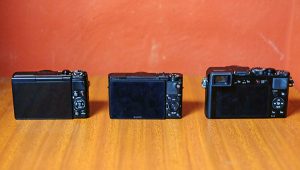
The
Lumix LX100 uses a bit of plastic to cover its left side, but the
majority of this construction is metal, much like the G7 X. However, of
the three it offers the least actual contact with the hard, cold stuff
thanks to its use of rubberised grips on the front and back.
All
three are extremely well made, with the Sony RX100 III having the most
dense, tight feel of the lot. Of course, this may be in part due to the
smooth finish it uses.
The one build disappointment I registered
was the Canon G7 X’s manual control ring. All three cameras offer some
form of control ring around the lens, but the action of the Canon’s clicky dial
is overly noisy and feels cheap next to the LX100’s
one.
On that point, which offers the greatest manual control?
Manual Control
Panasonic LX100 manual control
This
is the area where we really understand why the Panasonic Lumix LX100
benefits from being larger than the Sony RX100 III and Canon G7 X.
There’s much more to it than the handgrip.
The Panasonic LX100
offers manual control far in excess of the other cameras — or most
cameras on the market, in fact, including the majority of CSCs and lower-end DSLRs.
If you want to deep dive into manual photography, where you select the
aperture and shutter speed independently with every shot, this is one of
the best places to start.
On the lens you get a dedicated metal
aperture dial, which offers nice clicky increments. Next to it is a
smooth focus ring, but it can also be set to alter zoom and ISO (and
filters, but that’s not the kind of manual control we’re talking about
here).

On
the top plate are shutter speed and exposure compensation dials, again
with a definite, clicky action. Despite the camera’s relatively small
size, none of these elements feel cramped. Sensor size and lens optics
are one reason for the Panasonic LX100’s size, but it sits perfectly
with the kind of manual control here. This numer of control dials
probably wouldn’t work with the smaller two, especially not the dual
lens rings.
If you want manual control, there’s no contest. The LX100 wins.
There’s also a third lens control that lets you select the aspect ratio of your shots.
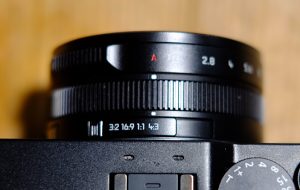
Canon G7 X manual control
The
Canon G7 X offers decent control, but it’s nowhere near what’s on offer
in the LX100. You get a context-sensitive lens control ring that, as
already mentioned, is a bit too loud in operation and feels a little
stiff and cheap. Definite clicks are good, but the action almost makes
it feel like a plastic ring, even though it is — like just about
everything else in the G7 X — metal.
The top-most control ring
on the top plate is the mode dial, giving you access to the usual
aperture priority and shutter priority modes. In these, the lens ring
can be used to select the key parameter, while in full manual the lens
ring is used to select aperture and the little rotary dial that sits
around the rear control pads sets shutter speed.
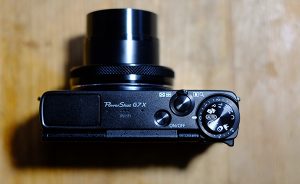
The
combo of small real dial and stiff control lens wheel makes manual
operation feel a bit unnatural, but we’re sure Canon G7 X buyers would
get used to it after a while.
What the G7 X offers over the
RX100 III is a separate exposure compensation dial that sits under the
main mode dial. Sat in this position you need to keep an eye on it as it
may be prone to knocks despite being, quite sensibly, fairly stiff. It
also reduces the comfort of general shooting, the raised mode dial
feeling as though it’s in the way at times.
We like what the
Canon G7 X sets out to do in terms of manual control, but it feels as
though it’s an annual refresh away from perfection. The controls are
there, but their feel is a little off.
Sony RX100 III manual control
The
RX100 III can seem like the most ‘point and shoot’ of all three
cameras, but it too offers reasonable manual controls. Like the previous
RX100 cameras, you get a lens ring and a rotary dial that sits around
the main nav control on the back.
Unlike the Panasonic and Canon
cameras, the lens ring here is entirely smooth — no clicky feedback at
all. However, I found it more pleasant to use than the stiff, loud Canon
wheel. Without obvious feedback you do need to keep more of an eye on
the display to judge exactly what setting you’re on, though.
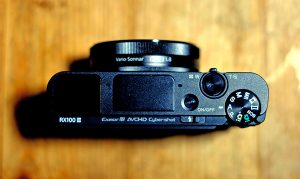
The
Mode dial sits almost flush with the top plate and offers aperture
priority, shutter priority and manual modes. Just like the G7 X, both
lens and rear controls can both be used in A/S modes and the lens ring
takes over aperture in full Manual, leaving shutter to the rear dial.
Changing
exposure and ISO takes longer with the RX100 III than the LX100,
although with the screen tilted out a few degrees and the camera held at
chest height, it’s fairly comfortable to use the manual controls.
EVF quality
Other
than offering decent physical controls, the other question often asked
of cameras aspiring to appeal to enthusiasts is whether they have a
viewfinder. Two of these do, but the cheaper Canon G7 X does not. If
you’re not going to be happy composing off a 3-inch screen, steer clear.
So which one has the better EVF, the Sony RX100 III or the Panasonic LX100?
The
Sony’s design is certainly a bit more dramatic. There’s a little
release toggle on the left side of the RX100 III that makes the unit pop
up. You then have to pull out the eyepiece lens manually to get the
image to focus.
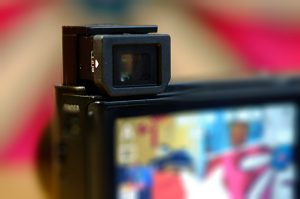
This
isn’t an everyday EVF, but rather one you’ll pull out in lighting
conditions where the LCD doesn’t quite cut it, such as in bright
sunlight. The Panasonic LX100 EVF is just there, 24/7, with a handy
rubberised eye guard that means you don’t need to get your face quite so
closer to the camera body.
Both cameras use a proximity sensor
that switches over to the EVF when it detects your face is in front of
the thing. No fiddling about with buttons is required.
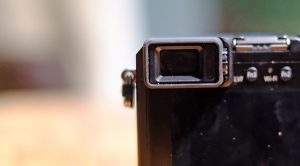
Which offers better quality? From the specs the LX100 seems to walk it, but it’s not that simple.
The
Sony RX100 III has a 1.44-million dot OLED EVF while the LX100’s LCD
one offers 2.4 million dots. Thats’s a huge difference, and the LX100’s
is noticeably sharper. However, given how great the hardware of the EVF
is, Panasonic has dropped the ball a bit in its implementation.
First,
the actual preview display only uses about 2/3s of the actual EVF’s
display space. This seems to be because the LX100 needs to make sure it
can fit 16:9 shot views into the space, but means that stubbier aspect
ratio shots look tiny: smaller than they do on the RX100 III. In all
cases, in fact, the Sony offers a larger image.
The LX100 EVF also emphasises contrast too much, making it a fairly weak indication of the final results.
Even
if its hardware is a good deal better than the Sony RX100 III’s, its
implementation is quite flawed and ultimately disappointing. The lower
resolution of the Sony EVF is quite obvious, but it is slightly easier
to work with.
Screen
All these cameras have 3-inch
screens, and unlike what we’ve seen so far, the Panasonic LX100’s
hardware appears to be the weakest of the lot. It brings the lowest
resolution, 921k dots, is non-touch and doesn’t tilt or swivel.
However,
we shouldn’t dwell on the resolution too much. The G7 X offers 1040k
dots and the Sony 1.23 million dots, but the RX100 III’s figures are
effectively inflated by its RGBW matrix. An extra white pixel lets it
increase brightness without draining too much battery, but this subpixel
doesn’t offer more picture information. Just brightness.
Resolution,
then, is pretty similar across the three. We did find that the Sony
RX100 III offers the most natural colour, although the Panasonic LX100
offers some screen calibration tools to let you tweak the character of
the display a bit.
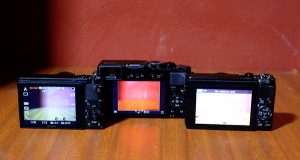
This
image makes the Panasonic screen look much more vivid that the others,
but in person they’re quite even in this respect. Note, though, that as
with the EVF, the LX100 doesn’t use its entire display as a preview
window. No matter which aspect ratio you pick, the display is never
quite filled. It’s a shame.
The Canon G7 X is the most
casual-friendly screen of the lot. It’s the only screen to offer touch
operation, letting you use touch focusing, much as you would with a phone
camera.
It offers 180-degree tilt, too – perfect for selfies or for shooting at any level below head height.
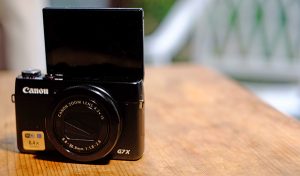
While
non-touch, the Sony RX100 III is offer the most versatile articulation.
It tilts down as well as up through 180 degrees, useful for shooting
above the head as well as below it. And, yes, it can do the selfie angle
if that’s what you’re after.
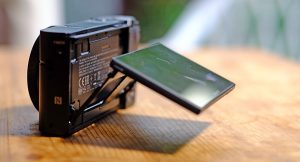
Lens
While
these cameras get a lot of attention for their larger-than-average
sensors, lens quality is just as important. With maximum apertures of up
to f/1.7, they are extremely fast, enabling the sort of creative
shallow depth of field effects that aren’t usually viable with a compact
camera.
Here are the basic specs of the lenses, using 35mm equivalent numbers:
Sony RX100 III: 24-70mm, max aperture up to f/1.8
Canon G7 X: 24-100mm, max aperture up to f/1.8
Panasonic LX100: 24-75mm, max aperture up to f/1.7
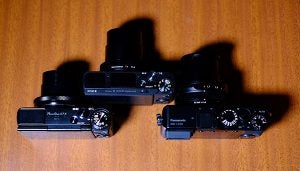
All
these lenses settle to a max aperture of f/2.8 as you use the zoom, but
we thought we’d take a closer look a their zoom ranges to find out how
well they hold on to their lens speed as the zoom is used.
Maximum aperture results
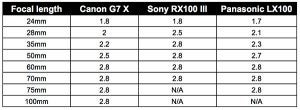
As
you can see, the Sony RX100 III is actually the weakest of the bunch
despite having the smallest zoom range. It settles down to f/2.8 by the
time it hits 35mm while the Panasonic LX100 and Canon G7 X can go that
bit wider right up until 60mm, where they join the Sony at f/2.8 max
aperture.
All three have ways to make their very wide apertures useful in daylight, where they’re at risk of causing overexposure.
The
Sony RX100 III and Canon G7 X use inbuilt ND filters, which limit the
amount of light that gets to the sensor. However, while the Sony’s can
be set to turn on automatically, you need to do so consciously with the
G7 X, which is a shame.
The Panasonic LX100 doesn’t have an ND
filters but does offer incredibly fast shutter speeds of up to 1/16,000
of a second. The others only go up to 1/2000 of a second.
With some reports that the LX100 lens is a bit soft wide open, we tried a
basic detail/sharpness test, all at 24mm, all with their max aperture
engaged. The results are below.
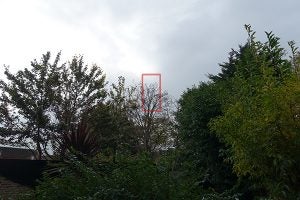
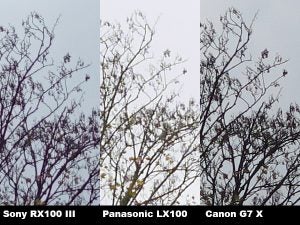
Here
we see that the Panasonic seems slightly reticent to use shutter speeds
higher than a ‘standard’ 1/2000 seconds, which has resulted in a much
brighter photo than the others. It has resulted in better colour, but
the sky is overexposed in parts, unlike the others.
The LX100 is
also slightly less sharp than the other two, although at this level
it’s likely to be as much down to the camera’s lower resolution as
anything to do with the lens.
We should also note that the Sony
RX100 III suffers from much clearer purple fringing than the other
cameras, although the effect isn’t too bad.
Quick disclaimer for
pixel-peepers… You’d never normally use this sort of setting for this
sort of scene — there are no real benefits to using such a wide
aperture in this kind of photo.
Autofocus performance
All three cameras use contrast
detection as their main focusing method. This is the standard type, not
the (potentially) faster phase detection kind.
Panasonic boasts
of the LX100’s ‘depth from defocus’ focusing aid, but really this is
just a software solution based on comparing the rate of defocusing when
the AF is searching.
In good lighting, all these cameras are
very fast among compacts. So we tried them in a bunch of very low-light
scenes to see which fares the best.
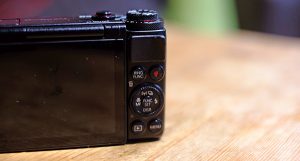
Despite
some reports to the contrary — some reviews suggest the RX100 III is
inconsistent — we found the Sony RX100 III to be generally the quickest
of the bunch. Despite the depth from defocus feature, the LX100 suffered
from the most obvious focus-searching periods.
We did find that
the Sony RX100 III could be a little vague in its focusing during
low-light shooting, though, not offering an exact point of focus, but
simply suggesting “some point of this scene is in focus. I’m off now,
bye.”
So for speed, it’s the Sony, but the others are a bit clearer about the results.
The Canon G7 X also has the benefit of touch focus, making casual snapping all the quicker.
Sensor and Image Quality
Which
has the best sensor? Well, the Panasonic LX100 certainly has the
largest one. It uses a Micro Four-Thirds sensor while the G7 X and RX100
III have 1-inch sensors, which seems to have become a standard for this
kind of camera.
However, the Panasonic LX100 doesn’t use its
entire sensor, instead using different portions of it depending on
whether you shoot 3:2, 16:9, 1:1 or 4:3 aspect pictures. It takes
12.5-megapixel pictures from the 16-megapixel sensor, giving you a good
idea of how much of the sensor is used.
The Sony RX100 III has a
20.1-megapixel 1-inch sensor and the Canon G7 X a 20.2-megapixel one.
Once again, Canon has deliberately made very similar moves to Sony.
You
get much higher-resolution pictures with the Canon and Sony. But do you
get better ones? We took the cameras into our labs to find out. Here
are their detail and dynamic range results:
The
results are interesting. It seems that despite being lower-res, the
Panasonic LX100 can harvest as much detail as the RX100 III in our
resolution test chart. The Canon G7 X gets slightly more detail, with
the difference becoming more apparent as you work up the ISO range.
The
Canon G7 X also outperforms the RX100 III in terms of dynamic range at
higher ISOs, although the Lumix LX100 is the clear victor here. As well
as offering significantly better maximum dynamic range, it’s better at
higher ISOs than either of the others. And unless you’re going to be
cropping into images a good deal, dynamic range matters more than fine
detail when it comes to a perception of image quality.
Video
What
about video? The Panasonic is the stand-out here, as it is the only one
to offer 4K video capture. The others max out at 1080p 60 frames per
second.
However, none is a true video replacement for something like the Panasonic GH4.
The Panasonic LX100 does not offer a microhone input despite having a
hotshoe where you could easily slot in a mic. The key function of this
hotshoe is to slot-in a flash, which comes in the box. It’s the only one
of these three cameras not to offer an inbuilt flash.
Verdict
For
those looking to get serious with their photography, we recommend the
Panasonic LX100. Its clear, high-quality manual controls encourage you
to be a much more active participant in your photos. There are auto
settings for everything, too, so you’re not forced into it. Panasonic’s implementation of the
technically impressive EVF needs work, though, and it’s not pocketable.
The
Canon G7 X sensor actually produces the most detail and has perhaps the
most impressive lens, with large maximum apertures and a good zoom
range, despite being the cheapest of the lot. We just don’t like its lens-wheel control, and without a viewfinder, some may struggle to
take it that seriously.
The Sony RX100 III
has stiff competition, then, but it’s still the only one of the three that
doesn’t have any hardware disappointments, beyond the lack of
a touchscreen (if that’s your bag). It’s the best all-rounder and the least likely to offend.
Ultimately, this is a superb trio of cameras, and proof that big-sensor compacts are now a force to be reckoned with.
Next, read our Best Cameras Round-up


